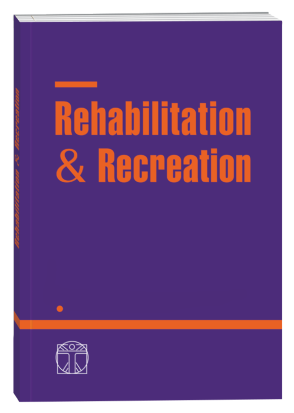CHARACTERISTICS OF PHYSICAL DEVELOPMENT AND BODY COMPOSITION OF OFFICERS WITH RISK OF CARDIOVASCULAR DISEASES
DOI:
https://doi.org/10.32782/2522-1795.2025.19.2.27Keywords:
excess body weight, officers, blood pressure, abdominal obesity, physique, physical developmentAbstract
The study involved 139 officers at risk of developing cardiovascular diseases, whose average age was 40.4±3.6 years. The study aimed to determine the factor structure based on a comprehensive analysis of the morphological state indicators of service members at risk of developing cardiovascular diseases and to investigate the influence of the selected factors on blood pressure indicators. The following research methods were used in the study: theoretical, anthropometric, bioimpedance analysis of body composition, and methods of mathematical statistics. Analysis of the officers' physical development indicators revealed a significant excess of the limit values of their neck circumference (median 40.0 cm, 25th and 75th percentiles 39.0 cm and 43.0 cm, respectively, with a norm of 37.0 cm) and a high prevalence of abdominal obesity in them (81.3% have an increased of waist circumference). Analysis of the results of the waist-to-hip ratio (WHR) index revealed that the majority of the officers (59%, n=82) have an average risk of developing abdominal obesity, but a significant proportion (25.2%, n=35) fall into the high-risk category. The maximum WHR value was 1.64, indicating severe abdominal obesity and an extremely high health risk in some cases. Analysis of the thickness of the skin-fat folds revealed a tendency to accumulate fat in the trunk area. In the majority of the officers, 87.1% (n=121), the thickness of the fold under the scapula, and in 70.5% (n=98), the fold on the abdomen exceeded 15 mm. Analysis of the body composition of the military personnel revealed a high prevalence of overweight and obesity (91.4% pers. had a body mass index above the WHO norm). A significant part of the subjects had an increased total fat content; in particular, the median value was 26.7% (standard 18.0÷25.0%). 12.2% of officers have excess visceral fat, and 14.4% have impaired hydration. The results of the body composition assessment revealed that the majority of the officers (73.4%) had signs of obesity, of which 37.4% had large body sizes, 36.0% had medium body sizes, and only 15.1% had a standard body type. To simplify the analysis of the influence of numerous indicators on the risk of cardiovascular diseases developing in military personnel, factor analysis using the principal component method was applied, which allowed us to identify three factors that collectively explain 65.6% of the total variance: ‘Body mass and body dimensions’ (36.1%), ‘Fat and muscle mass content’ (21.4%) and ‘Localization of fat deposits’ (8.1%). Correlation analysis revealed statistically significant direct correlations between the complex of anthropometric indicators and blood pressure levels. The strongest correlations were observed between waist circumference and systolic (r= 0.401, p<0.001) and diastolic (r=0.347, p<0.001) blood pressure, confirming the role of abdominal obesity as a significant risk factor for arterial hypertension. Similar, although somewhat weaker, relationships were observed between neck circumference (r=0.381 and r=0.359 for systolic and diastolic blood pressure, respectively, p<0.001). Conclusions. The identified violations of the normative values in the vast majority of the studied indicators of physical development and body composition closely correlate with the blood pressure level. This emphasizes the study's relevance and indicates the need to implement comprehensive preventive measures to correct lifestyle, nutrition, and physical activity to improve health and reduce the risk of developing cardiovascular diseases.
References
1. Aljasir, B.A., Al-Mugti, H.S., Alosaimi, M.N., & Al-Mugati, A.S. (2017). Evaluation of the National Guard Health Promotion Program for Chronic Diseases and Comorbid Conditions Among Military Personnel in Jeddah City, Saudi Arabia, 2016. Military medicine, 182 (11), 1973–1980. https://doi.org/10.7205/MILMED-D-17-00166
2. Clerc, P.G., Mayer, S.B., & Graybill, S. (2022). Overweight BMI (25-29) in Active Duty Military: Excess Fat or More Lean Mass. A Look at the Evidence. Military medicine, 187(7–8), 201–203. https://doi.org/10.1093/milmed/usab447
3. Dawood, J., Mancuso, J.D., Chu, K., Ottolini, M., & Ahmed, A E. (2024). The Relationship Between Physical Activity Profiles and Cardiovascular Disease Risk Factors: Results of a Cross-Sectional Survey of Active-Duty U.S. Service Members. Military medicine, 381. https://doi.org/10.1093/milmed/usae381
4. Drozdovska, S., Andrieieva, O., Yarmak, O., & Blagii, O. (2020). Personalization of health-promoting fitness programs for young women based on genetic factors. Journal of Physical Education and Sport, 20, 331–337. https://doi.org/10.7752/jpes.2020.s1046
5. Fortes, M.S.R., Rosa, S.E.D., Coutinho, W., & Neves, E.B. (2019). Epidemiological study of metabolic syndrome in Brazilian soldiers. Archives of endocrinology and metabolism, 63(4), 345–350. https://doi.org/10.20945/2359-3997000000115
6. Gazdzinska, A., Baran, P., Turczynska, M., & Jagielski, P. (2023). Evaluation of health behaviours of Polish Army soldiers in relation to demographic factors, body weight and type of Armed Forces. International journal of occupational medicine and environmental health, 36(4), 437–449. https://doi.org/10.13075/ijomeh.1896.02114
7. Heinrich, K.M., Jitnarin, N., Suminski, R.R., Berkel, L., Hunter, C.M., Alvarez, L., Brundige, A.R., Peterson, A.L., Foreyt, J.P., Haddock, C.K., & Poston, W.S. (2008). Obesity classification in military personnel: a comparison of body fat, waist circumference, and body mass index measurements. Military medicine, 173(1), 67–73. https://doi.org/10.7205/milmed.173.1.67
8. Kammar-Garcia, A., Hernandez-Hernandez, M.E., Lopez-Moreno, P., Ortiz-Bueno, A.M., & Martinez-Montaño, M.L. (2019). Relation of body composition indexes to cardiovascular disease risk factors in young adults. Semergen, 45(3), 147–155. https://doi.org/10.1016/j.semerg.2018.07.004
9. Kim, K., Choi, J., Lee, O., Lim, J., & Kim, J. (2023). The Effects of Body Composition, Physical Fitness on Time of Useful Consciousness in Hypobaric Hypoxia. Military medicine, 188(7–8), 2082–2088. https://doi.org/10.1093/milmed/usac412
10. Lee, B.N., Bae, S.W., Oh, S.Y., Yoon, J.H., Roh, J., & Won, J.U. (2022). Effects of military life on changes in body mass index of enlisted men: a cross-sectional study. BMJ military health, 168(3), 218–223. https://doi.org/10.1136/bmjmilitary-2019-001401
11. Lundell, R., Saarelainen, R., Parkkola, K., & Wuorimaa, T. (2024). A 15-Year Longitudinal Study of Body Composition in Finnish Military Divers. Military Medicine, 189(9–10), 2023–2029. https://doi.org/10.1093/milmed/usad401
12. Mayer, S.B., Graybill, S., Raffa, S.D., Tracy, C., Gaar, E., Wisbach, G., Goldstein, M.G., & Sall, J. (2021). Synopsis of the 2020 U.S. VA/DoD Clinical Practice Guideline for the Management of Adult Overweight and Obesity. Military medicine, 186(9–10), 884–896. https://doi.org/10.1093/milmed/usab114
13. Mykhaylov, V.V., Korostylova, Y.S., & Mykhaylov, V.V. (2024). Body weight evaluation of soldiers according to a 100-point rating scale. Physical Education and Sports, (1), 81–93. https://doi.org/10.26661//2663-5925-2024-1-11
14. Naghii M.R. (2006). The importance of body weight and weight management for military personnel. Military medicine, 171(6), 550–555. https://doi.org/10.7205/milmed.171.6.550.
15. Petrachkov, O., & Yarmak, O. (2023). Analysis of physical development indicators of operational level officers of different age groups. Bulletin of the Kamianets-Podilskyi National Ivan Ohiienko University. Physical Education, Sport and Human Health, 28(2), 122–129. https://doi.org/10.32626/2309-8082.2023-28(2).122-129
16. Petrachkov, O., Yarmak, O., & Kuvshynov, O. (2023). Assessment of the level of physical fitness of operational level officers with limited functional capabilities according to physical condition indicators. Scientific Journal of M.P. Drahomanov National Pedagogical University. Series 15, Scientific and Pedagogical Problems of Physical Culture (Physical Culture and Sports), 9(169), 127–131. https://doi.org/10.31392/NPUnc.series15.2023.9(169).27
17. Petrachkov, O.V., Kyslenko, D.P., Mykhaylov, V.V., Shostak, R., & Polyvaniuk, V. (2024). Motivation of military specialists to engage physical training during the legal regime of martial law. Journal of Physical Education and Sport, Vol. 24 (issue 6), 1457–1464. https://efsupit.ro/images/stories/june2024/Art%20165.pdf
18. Quertier, D., Goudard, Y., Goin, G., Regis-Marigny, L., Sockeel, P., Dutour, A., Pauleau, G., & De La Villeon, B. (2022). Overweight and Obesity in the French Army. Military medicine, 187(1–2), 99–105. https://doi.org/10.1093/milmed/usaa369
19. Ravani, J.P.R., Sbaffi, B.C., Monteiro, A.C., Carrocino, K.M.C., Doimo, L.A., & Ferreira, F.G. (2023). The Visceral Adiposity Index Is a Better Predictor of Excess Visceral Fat in Military Pilots: A Cross-sectional Observational Study. Military medicine, 188(7–8), 2003–2009. https://doi.org/10.1093/milmed/usac319
20. Rostami, H., Tavakoli, H.R., Rahimi, M.H., & Mohammadi, M. (2019). Metabolic Syndrome Prevalence among Armed Forces Personnel (Military Personnel and Police Officers): A Systematic Review and Meta-Analysis. Military medicine, 184(9–10), 417–425. https://doi.org/10.1093/milmed/usz144
21. Russell, D.W., Kazman, J., & Russell, C.A. (2019). Body Composition and Physical Fitness Tests Among US Army Soldiers: A Comparison of the Active and Reserve Components. Public health reports (Washington, D.C.: 1974), 134(5), 502–513. https://doi.org/10.1177/0033354919867069
22. Shiozawa, B., Madsen, C., Banaag, A., Patel, A., & Koehlmoos, T. (2019). Body Mass Index Effect on Health Service Utilization Among Active Duty Male United States Army Soldiers. Military medicine, 184(9-10), 447–453. https://doi.org/10.1093/milmed/usz032
23. Singh, P., Covassin, N., Marlatt, K., Gadde, K.M., & Heymsfield, S.B. (2021). Obesity, Body Composition, and Sex Hormones: Implications for Cardiovascular Risk. Comprehensive Physiology, 12(1), 2949–2993. https://doi.org/10.1002/cphy.c210014
24. Stergiou, M., Robles-Perez, J.J., Rey-Mota, J., Tornero-Aguilera, J.F., & Clemente-Suárez, V.J. (2023). Psychophysiological Responses in Soldiers during Close Combat: Implications for Occupational Health and Fitness in Tactical Populations. Healthcare (Basel, Switzerland), 12(1), 82. https://doi.org/10.3390/healthcare12010082
25. Tarabeih, N., Kalinkovich, A., Ashkenazi, S., Cherny, S.S., Shalata, A., & Livshits, G. (2024). Analysis of the Associations of Measurements of Body Composition and Inflammatory Factors with Cardiovascular Disease and Its Comorbidities in a Community-Based Study. Biomedicines, 12(5), 1066. https://doi.org/10.3390/biomedicines12051066
26. Yang, D., Beauvais, A., Forbes, W.L., Beckman, D., Estes, J., Martinez, C., & Wardian, J. (2022). Relationship Between Body Mass Index and Diagnosis of Obesity in the Military Health System Active Duty Population. Military medicine, 187(7–8), 948–954. https://doi.org/10.1093/milmed/usab292
27. Yarmak, O., Chernalivska, O., & Shevchenko, I. (2024). Analysis of physical development and body composition in female military personnel. Sport Science Spectrum, 1, 122–128. https://doi.org/10.32782/spectrum/2024-1-19
28. Zhou, J.-y., Ge, H., Zhu, M.-f., et al. (2013). Neck circumference as an independent predictive contributor to cardio-metabolic syndrome. Cardiovascular Diabetology, 12, 76. https://doi.org/10.1186/1475-2840-12-76
Downloads
Published
How to Cite
Issue
Section
License

This work is licensed under a Creative Commons Attribution-NonCommercial-NoDerivatives 4.0 International License.





